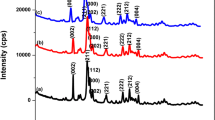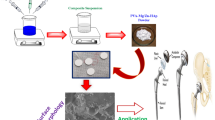Abstract
Hydroxyapatite (HAp) nanostructures may be an advanced candidate in biomedical applications for an apatite substitute of bone and teeth than other form of HAp. In contrast, well-defined size and shape control in synthesizing HAp nanostructures is always difficult. In this study, hydroxyapatite nanorods (HAp NRs) were prepared by simple hydrothermal method with controlling the reaction time without using any surfactant or templating agents. The nanostructure clearly depicts the growth stages of the HAp NRs by increasing the reaction time. The synthesized HAp has the rod like morphology with uniform size distribution with the aspect ratio of about 8–10. Transmission electron microscopic (TEM) and high resolution TEM (HRTEM) images show that the growth direction of the HAp is parallel to the (001) plane. The interplanar distances measured in segments (fringes) of the HRTEM micrograph were ~0.35 nm, corresponding to the interplanar spacing of the (002) plane of the hexagonal HAp. X-ray diffraction (XRD) measurements indicate that the improved crystallinity of the HAp by increasing the reaction time. The mechanical studies reveal that the improved tensile strength and the abrasion resistance are observed for the HAp nanorods reinforcing with high molecular weight polyethylene (HMWPE).











Similar content being viewed by others
References
Aizawa M, Ueno H, Itatani K, Okada I (2006) Syntheses of calcium-deficient apatite fibers by a homogeneous precipitation method and their characterizations. J Eur Ceram Soc 26:501–507
Anmin H, Tong L, Ming L, Chengkang C, Huiqin L, Dali M (2006) Preparation of nanocrystals hydroxyapatite/TiO2 compound by hydrothermal treatment. Appl Catal B 63:41–44
Blakeslee KC, Condrate RA (1971) Vibrational spectra of hydrothermally prepared hydroxyapatites. J Am Ceram Soc 54:559–563
Cao M, Wang Y, Guo C, Qi Y, Hu C (2004) Preparation of ultrahigh-aspect-ratio hydroxyapatite nanofibers in reverse micelles under hydrothermal conditions. Langmuir 20:4784–4786
Chang MC, Ko C, Douglas WH (2003) Preparation of hydroxyapatite-gelatin nano composite. Biomaterials 24:2853–2862
Chen B, Liang C (2007) Preparation of hydroxyapatite coating by the use of a sacrificial Mg anode method. Ceram Int 33:701–703
Chen JD, Wang YJ, Wei K, Zhang SH, Shi XT (2007) Self-organization of hydroxyapatite nanorods through oriented attachment. Biomaterials 28:2275–2280
Cheng ZH, Yasukawa A, Kandori K, Ishikawa T (1998) FTIR study on incorporation of CO2 into calcium hydroxyapatite. J Chem Soc Faraday Trans 94:1501–1505
Cho SH, Joo SM, Cho JS, Lee JK, Kim H (2005) Mechanical properties and workability of self-hardening calcium phosphate cement as a function of the particle size distribution. J Ceram Process Res 6:57–62
Di NS, Brovarone CV, Spriano S, Milanese D, Verne E, Bergo V, Maina G, Spinelli P (2004) Silver containing bioactive glasses prepared by molten salt ion-exchange. J Eur Ceram Soc 24:2935–2942
Elliott JC (1994) Structure and chemistry of the apatites and other calcium orthophosphates. Elsevier, Amsterdam
Elliott JC (1998) Recent studies of apatites and other calcium orthophospates. In: Bres E, Hardouin P (eds) Calcium phosphate materials, fundamentals. Sauramps Medical, Monpellier, p 25
Feng X, Ye J, Wang Y, Rao P (2005) Deagglomeration of HA during the precipitation synthesis. J Mater Sci 40(20):5439–5442
Hench LL (1991) Bioceramics: from concept to clinic. J Am Ceram Soc 74:1487–1510
Hirai T, Hodono M, Komasawa I (2000) The preparation of spherical calcium phosphate fine particles using an emulsion liquid membrane system. Langmuir 16:955–960
Huang J, Lin YW, Fu XW, Best SM, Brooks RA, Rushton N et al (2007) Development of nano-sized hydroxyapatite reinforced composites for tissue engineering scaffolds. J Mater Sci Mater Med 18(11):2151–2157
Hulber SF, Bokros JC, Hench LL, Wilson J, Heimke G (1987) Ceramics in clinical applications: past, present and future. In: Vincenzini P (ed) High tech ceramics. Elsevier, Amsterdam, pp 189–213
Kobayashi S, Kawai W (2007) Development of carbon nanofiber reinforced hydroxyapatite with enhanced mechanical properties. Compos A 38:114–123
Lewandrowski KU, Bondre SP, Wise DL, Trantolo DJ (2003) Enhanced bioactivity of a poly(propylene fumarate) bone graft substitute by augmentation with nano-hydroxyapatite. Biomed Mater Eng 13(2):115–124
Lin K, Chang J, Cheng R, Ruan M (2007) Hydrothermal microemulsion synthesis of stoichiometric single crystal hydroxyapatite nanorods with mono-dispersion and narrow-size distribution. Mater Lett 61:1683–1687
Maquet V, Boccaccini AR, Pravata L, Notingher I, Jerome R (2004) Porous poly(α-hydroxyacid)/BioglassR composite scaffolds for bone tissue engineering. I: preparation and in vitro characterisation. Biomaterials 25:4185–4194
Markovíc M, Flower BO, Tung MS (2004) Preparation and comprehensive characterization of a calcium hydroxyapatite reference material. J Res Natl Inst Stand Technol 109:553–568
Mathieu LM, Mueller TL, Bourban PE, Pioletti DP, Muller R, Manson JAE (2006) Architecture and properties of anisotropic polymer composite scaffolds for bone tissue engineering. Biomaterials 27:905–916
Ramay HRR, Zhang M (2004) Biphasic calcium phosphate nanocomposite porous scaffolds for load-bearing bone tissue engineering. Biomaterials 25:5171–5180
Rodriguez-Lorenzo LM, Vallet-Regi M (2000) Controlled crystallization of calcium phosphate apatites. Chem Mater 12:2460–2465
Roeder RK, Sproul MM, Turner CH (2003) Hydroxyapatite whiskers provide improved mechanical properties in reinforced polymer composites. J Biomed Mater Res 67A:801–812
Sarda S, Heughebaert M, Lebugle A (1999) Influence of the type of surfactant on the formation of calcium phosphate in organized molecular systems. Chem Mater 11:2722–2727
Shen Z, Adolfsson E, Nygren M, Gao L, Kawaoka H, Niihara K (2001) Dense hydroxyapatite-zirconia ceramic composites with high strength for biological applications. Adv Mater 13:214–216
Shi Z, Huang X, Cai Y, Tang R, Yang D (2009) Size effect of hydroxyapatite nanoparticles on proliferation and apoptosis of osteoblast-like cells. Acta Biomater 5:338–345
Shiha WJ, Wangb MC, Hona MH (2005) Morphology and crystallinity of the nanosized hydroxyapatite synthesized by hydrolysis using cetyltrimethylammonium bromide (CTAB) as a surfactant. J Cryst Growth 275:e2339–e2344
Siegel RW, Fougere GE (1995) Mechanical properties of nanophase metals. Nanostruct Mater 6:205–216
Suchanek W, Yashima M, Kakihana M, Yoshimura M (1997) Hydroxyapatite/hydroxyapatite-whisker composites without sintering additives: mechanical properties and microstructural evolution. J Am Ceram Soc 80:2805–2813
Sun Y, Guo G, Wang Z, Guo H (2006) Synthesis of single-crystal HAP nanorods. Ceram Int 32:951–954
Sun Y, Guo G, Tao D, Wang Z (2007) Reverse microemulsion-directed synthesis of hydroxyapatite nanoparticles under hydrothermal conditions. J Phys Chem Solids 68:373–377
Walsh D, Mann S (1996) Chemical synthesis of microskeletal calcium phosphate in bicontinuous microemulsions. Chem Mater 8:1944–1953
Wang M (2003) Developing bioactive composite material for tissue replacement. Biomaterials 24:2133–2151
Wang YJ, Zhang SH, Wei K, Zhao N, Chen JD, Wang XD (2006a) Hydrothermal synthesis of hydroxyapatite nanopowders using cationic surfactant as a template. Mater Lett 60:1484–1487
Wang YJ, Chen JD, Wei K, Zhang SH, Wang XD (2006b) Surfactant-assisted synthesis of hydroxyapatite particles. Mater Lett 60:3227–3231
Webster TJ (2001) Nanophase ceramics: the future orthopedic and dental implant material. In: Ying JY (ed) Nanostructured materials. Academic Press, San Diego, pp 125–160
Webster TJ, Siegel RW, Bizios R (1999) Design and evaluation of nanophase alumina for orthopaedic/dental applications. Nanostruct Mater 12:983–986
Wei G, Ma PE (2004) Structure and properties of nano-hydroxyapatite/polymer composite scaffolds for bone tissue engineering. Biomaterials 25:4749–4757
Yang W, Araki H, Kohyama A, Thaveethavorn S, Suzuki H, Noda T (2004) Fabrication in situ SiC nanowires/SiC matrix composite by chemical vapour infiltration process. Mater Lett 58:3145–3148
Yaszemski MJ, Payne RG, Hayes WC, Lander R, Mikos AG (1996) Evolution of bone transplantation: molecular, cellular and tissue strategies to engineer human bone. Biomaterials 17:175–185
Yuan ZY, Liu JQ, Peng LM (2002) Morphosynthesis of vesicular mesostructured calcium phosphate under electron irradiation. Langmuir 18:2450–2452
Zhang F, Zhou ZH, Yang SP, Mao LH, Chen HM, Yu XB (2005) Hydrothermal synthesis of hydroxyapatite nanorods in the presence of anionic starburst dendrimer. Mater Lett 59:1422–1425
Zhu K, Yanagisawa K, Onda A, Kajiyoshi K (2004) Hydrothermal synthesis and morphology variation of cadmium hydroxyapatite. J Solid State Chem 177:4379–4385
Acknowledgments
One of the authors AJN gratefully acknowledges the financial support from the Ministry of Higher Education, Taiwan, through Taiwan-India Collaborative Research Project. The authors also thank Mr. Wu Jun Jie and Mr. Dann Yu for their help in taking FESEM and TEM analysis. We are also indebted to Centre for EMO Materials and Nanotechnology, National Taipei University and Technology for Mechanical studies.
Author information
Authors and Affiliations
Corresponding author
Rights and permissions
About this article
Cite this article
Joseph Nathanael, A., Mangalaraj, D., Chi Chen, P. et al. Enhanced mechanical strength of hydroxyapatite nanorods reinforced with polyethylene. J Nanopart Res 13, 1841–1853 (2011). https://doi.org/10.1007/s11051-010-9932-3
Received:
Accepted:
Published:
Issue Date:
DOI: https://doi.org/10.1007/s11051-010-9932-3




